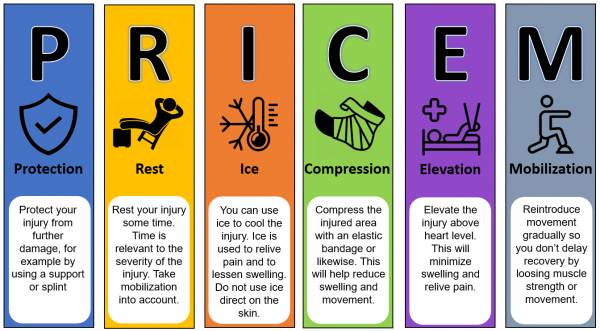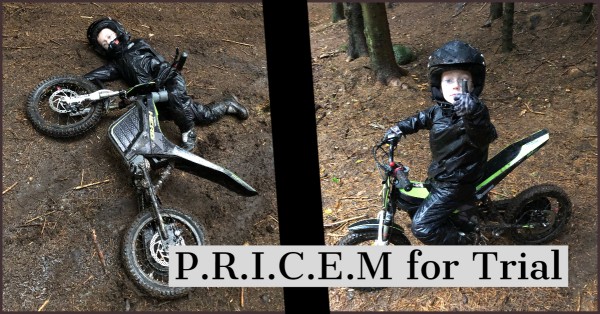When it comes to motorsport – and especially at Trial – you (as the trainer/parent) must provide the first aid in the event of a crash. It is important as a rider, trainer and parent that we can provide the necessary first aid.
In this article I will not deal with ordinary first aid. There are lots of good courses – both online, in organizations or at workplaces where that information is available. I would strongly recommend that you know how to provide basic first aid and practice it regularly.
Not just because of your sport, but in general.
In this article, we will look specifically at the first aid to be provided when it comes to sports injuries. Both to ensure the rider as little injury as possible and as short a recovery time as possible.
Remember always to consult a doctor for guidance and advice when it concerns a injury.
The P.R.I.C.E.M method of sports injuries
In case of sudden and acute injuries, such as sprain of the ankle and twist in the knee, the first hours can be decisive for how well the injury heals and how fast the rider recovers.
It is often these types of sprain or twist injuries that we see at Trial.
We want to reduce bleeding and swelling, provide pain relief and check that the damage does get worse.
An important tool for treating this type of injury is using the P.R.I.C.E.M principle.
The letters in P.R.I.C.E.M stand for their treatment intervention:
P: Protection
R: Rest
I: Ice
C: Compression
E: Elevation
M: Mobilisation

Protection and Rest
The first 2 stages of PRICEM, protection and rest, are closely related. The current activity must be stopped immediately so that the damage to e.g. ligaments or muscles do not get worse, and the damaged structure must be relieved. In case of severe ankle sprains or twist of the knee, it is recommended to relieve the joint if necessary and to use crutches immediately after the injury.
In this way the joint is not stressed any further.
For severe knee injuries, it is further recommended to apply a knee rail for total relief.
In this case, it is of course important to get a recommendation from your own doctor.
Ice
It is recommended to cool the affected area as soon as possible after the injure has occurred. An ice bag is perfect to the job. The ice causes the blood vessels to contract and minimizes bleeding in the area. But the contraction of the blood vessels is minimal and occurs slowly, so you must always apply compression combination with ice.
The primary benefit of cooling the injury is providing local pain relief.
The ice must not come directly contact with the skin, as there is a risk of frostbite. It is therefore an advantage to lay the ice on top of a compression bandage.
The treatment with ice, is used 20 minutes every hour for a minimum of 3 hours, if there is an effect, or as needed.
Compression
Compression is the most important part of the acute injury treatment after the activity is stopped and the injured structure is protected and at rest. A compression bandage on the joint is the most effective. The first few hours after the injury, the compression bandage may be very tight to minimize swelling and reduce bleeding. After the first few hours, a more moderately tight compression is worn. At nighttime, it is recommended to remove the compression bandage or use a loose bandage to avoid stopping blood circulation and thereby causing tissue damage.
In addition to compression, kinesio tape may be considered to minimize and eliminate bleeding in the tissue.
Elevation
The injured region should be elevated above heart as it helps minimize bleeding and reduce swelling. It is recommended to use elevation regularly, for as long as there is swelling.
Mobilization
Relatively shortly after the injury, easy mobilization is recommended to use the body’s venous pump system to transport the swelling away from the damaged area. This can be done by straightening your back with your leg up and moving your foot back and forth, in case of an ankle sprain.
This mobilization can gradually increase, so that the joint is mobilized more vigorously and with greater load. Be careful not to move too fast here, as this can reverse the healing process.
Rounding off.
I hope the article hasn’t put you off, and that I can convince you to use the principle of PRICEM.
In the 3 years my son has bee riding Trial, he has had a load of crases. Most of them has been without any injures, the occasional bruise or broken lip. On one occasion we needed the use of the PRICEM, and that was in the case of a dislocated elbow joint. Even though serious injuries are rare in Trial, you need to know how to act in case that it occurs.
By using the simple principles of PRICEM you can ensure the injured rider a shorter and less painful injury period with fewer complications as well as a faster return to the sport.
Remember that it is important for the rider’s psyche to get back up and riding quickly. In motorsport, we sometimes get some formidable crashes, where we get beat up badly. It is important that the rider gets back on the motorcycle as soon as possible, so that the crash does not “settle” in the body and that the rider becomes afraid of riding. This applies to both children and adults.
It is important that you always seek contact with your own doctor, or possibly an emergency room if in doubt




 Training wheels and motorcycles.
Training wheels and motorcycles.
